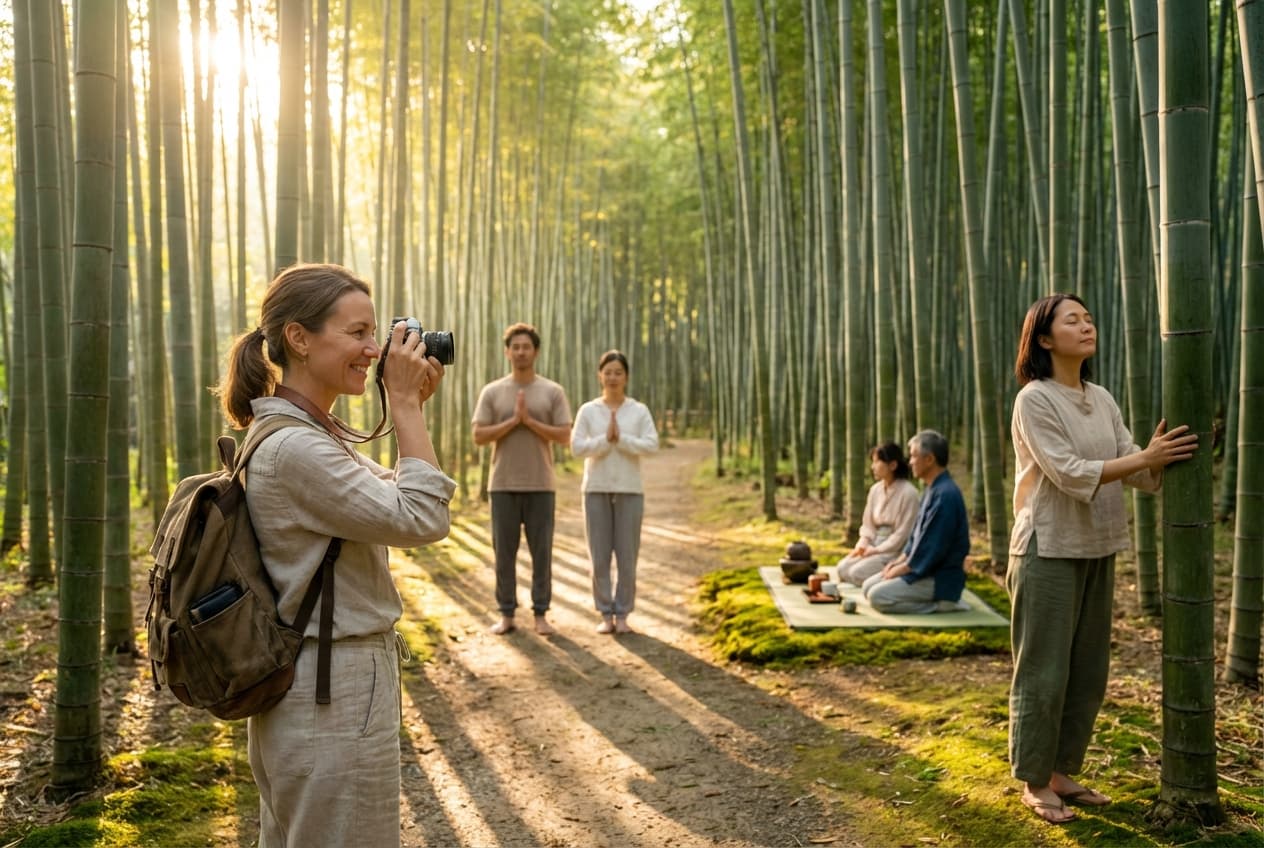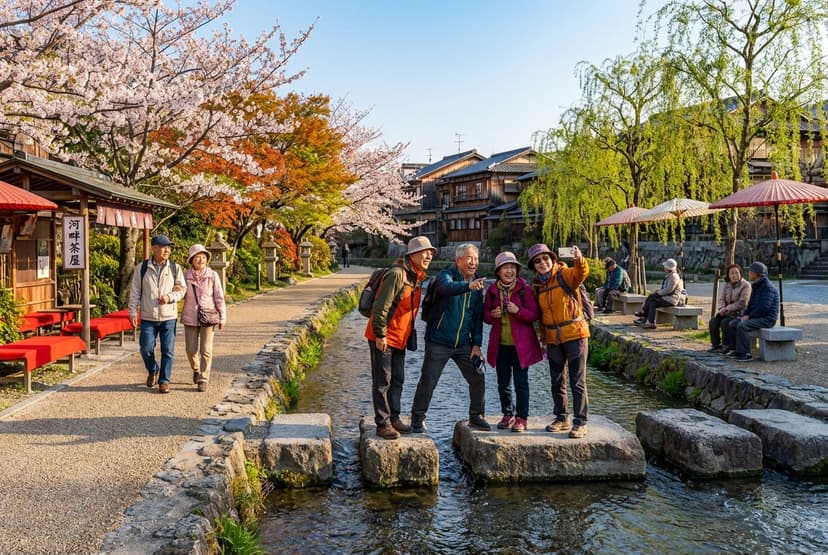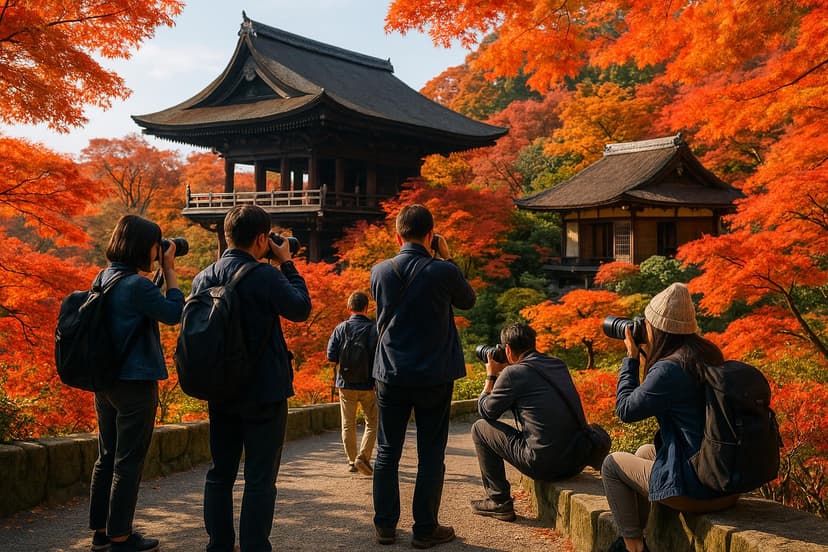Kyoto: Temple Dawns, Tea Rituals & Bamboo Forest Bathing — 4-Day Mindful Retreat

A slow-paced, autumnal four-day Kyoto itinerary for a mindful traveler. Early-morning temple visits, intimate tea rituals, gentle yoga & meditation, and quiet forest bathing in Arashiyama. Designed for reflection, seasonal foliage, and restorative pacing in November.
Highlights
- Dawn at Kiyomizu-dera and Fushimi Inari to catch stillness before the crowds
- Sagano bamboo grove and Tenryu-ji garden for immersive forest bathing
- Traditional tea ceremony at Urasenke and matcha tasting at Ippodo
- Zen meditation at Shunkoin and contemplative time at Ryoan-ji rock garden
Itinerary
Day 1
Gentle arrival, settling into a ryokan, and a calm afternoon along the Philosopher's Path to tune into Kyoto's autumn colors.
Check in and settle — Ryokan Yachiyo
Arrive, leave luggage, and take 45–60 minutes to breathe, change, and orient yourself in a tatami room with a small garden view.
Tips from local experts:
- Ask for a room with a garden view to enjoy morning light and a quiet place for seated breathing.
- Keep shoes off in the ryokan — use this arrival moment to practice a slow mindful shoe-removal ritual.
- If you have luggage, request help from staff to avoid heavy carrying on narrow lanes; they can store items securely.
Slow afternoon walk — Philosopher's Path
An easy, contemplative stroll along the canal-side path famed for autumn color; move slowly, pause at small shrines and benches.
Tips from local experts:
- Walk at an unhurried pace; stop to sit on a bench and practice 5–10 minutes of mindful breathing while observing falling leaves.
- The path is narrow in places; start from the southern end (near Ginkaku-ji) to avoid groups coming the opposite way.
- Public toilets are spaced out — note them early if you prefer uninterrupted sitting stops.
Afternoon tea pause — Ippodo Tea (matcha tasting)
A quiet sit-down tea tasting to learn simple matcha preparation and savor a traditional wagashi confection.
Tips from local experts:
- Request a seat by the window if available; the slower light of November makes for a calm, reflective tea moment.
- Tell staff you're seeking a quiet experience — they often offer a calmer corner and will explain proper sipping etiquette.
- If you have sensitive mobility, ask for a low table or chair seating; some locations offer both tatami and chair options.
Short guided zazen — Shunkoin Temple (introductory sit)
A gentle, introductory seated meditation to ground the day and adjust to temple quietude; suitable for first-timers.
Tips from local experts:
- Dress in layered clothing — temples can be cool in November; comfortable, modest clothing helps for sitting.
- If you have knee or hip concerns, request a cushion (zafu) or chair in advance so you can maintain comfort.
- Arrive 10 minutes early to remove shoes and tune into silence; take a few mindful breaths before the formal start.
Quiet dinner at the ryokan — mindful kaiseki or simple set
A calm, seasonal dinner at Ryokan Yachiyo focusing on small courses, local vegetables and simple presentation for reflective dining.
Tips from local experts:
- Ask for the seasonal (autumn) menu to taste local mountain vegetables — eat slowly and savor textures as a form of meditation.
- If you prefer low-stimulation dining, request a quiet table away from the kitchen and larger groups.
- Use chopsticks mindfully: pause between courses to appreciate the aroma and warmth of each bite.
Day 2
Dawn temple ritual, a formal tea ceremony, deeper Zen practice and a gentle evening in Gion — paced for reflection and warm beverages in the cool November air.
Dawn visit to Kiyomizu-dera — sunrise and quiet prayer
Arrive before the morning crowds to experience Kiyomizu-dera's wooden terraces and autumn foliage in a hushed light.
Tips from local experts:
- Aim to arrive 30–45 minutes before sunrise for the softest light and near solitude on the terrace.
- The walk involves steps and slopes; bring a light headlamp if you plan pre-dawn walking and wear grippy shoes.
- Find a bench or low wall to sit and practice silent gratitude for 5–10 minutes while facing the city view.
Tea and light breakfast — Ippodo Tea Kyoto (calm morning matcha)
Return to central Kyoto for a second, leisurely tea-focused breakfast: single-origin whisked matcha and a small sweet.
Tips from local experts:
- Ask for a demonstration of whisking; engaging the hands can be a grounding mindful ritual after the dawn visit.
- Sit quietly and pace your tea slowly — in November the room will be warm compared with the outside air, which aids relaxation.
- If you need a quiet corner, call ahead; mornings are calmer than midday and staff will often seat contemplative guests appropriately.
Formal tea ceremony — Urasenke Chado Research Center
Participate in a short, authentic tea ceremony to learn the meditative gestures, timing, and the spiritual simplicity of chadō.
Tips from local experts:
- Reserve in advance; seats are limited and November is popular for tea-related events during leaf season.
- Wear quiet, respectful clothing (no heavy perfume) to fully engage with the sensory simplicity of the ceremony.
- Arrive 10 minutes early to be briefed on posture and how to accept and savor the bowl as a form of slow presence.
Lunch — Omen Kodai-ji (simple, seasonal udon set)
A warming, lightly seasoned udon meal near Kodai-ji — understated, nourishing, and slow to eat.
Tips from local experts:
- Order a set with seasonal vegetables to keep the meal light and restorative for continued walking.
- Sit at a corner table if available for a private, slow-paced lunch experience.
- If you have dietary needs, politely ask staff — many places are accommodating with advance notice.
Afternoon Zen session — Shunkoin (deeper zazen & reflection)
A longer guided zazen session with time for short dharma talk and quiet Q&A in English-friendly setting.
Tips from local experts:
- Book ahead for the workshop format; mention mobility needs to secure a chair option if needed.
- Use this session to practice a breathing anchor (inhale 4, exhale 6) to steady the mind in cold November air.
- Stay afterward for a few minutes of silent journaling; Shunkoin's courtyard is ideal for gentle reflection.
Gion walking hour — quiet streets at dusk
A slow, observational walk through the quieter lanes of Gion; focus on architecture, lanterns, and seasonal light.
Tips from local experts:
- Stay on the side lanes rather than Hanami-koji to avoid tourist groups; side lanes are calmer and perfect for reflection.
- Bring a small notebook to note visual impressions rather than photographing extensively — this deepens memory.
- If you feel like tea again, duck into a small machiya cafe for a brief restorative sit rather than a long meal.
Evening unwind — in-room relaxation
Return to the ryokan to soak (if available), journal, and allow stillness before sleep.
Tips from local experts:
- Use an evening warm soak to help regulate sleep after early starts; keep it brief and meditative.
- Write three small impressions from the day to close the practice of being present with your experiences.
- Turn phone to airplane mode and place it out of immediate reach to preserve a quiet digital boundary.
Day 3
Arashiyama day: early bamboo-grove bathing, garden tea at Okochi Sanso, gentle riverside walking, and an optional moss-garden (Kokedera) visit in the calm late afternoon.
Early Sagano bamboo grove stroll — forest bathing
Walk slowly through the bamboo grove while the stems sway and the morning light filters through — emphasize silence and breath.
Tips from local experts:
- Arrive early to avoid tour groups and practice a walking meditation: step, breathe, listen for wind in the bamboo.
- Wear layered clothing — the grove can feel cool and shaded in November mornings even if the sun is out.
- Respect the grove's flow: keep voices low, step to the side to let small groups pass, and avoid flash photography.
Tenryu-ji — garden contemplation
Visit Tenryu-ji's Sogenchi garden, designed for quiet viewing and to support an unhurried gaze across water and autumn foliage.
Tips from local experts:
- Walk the garden circuit slowly and pause at the viewing pavilion for 10 minutes of silent sitting.
- Bring a small travel blanket if you want a seated break on the garden edge — many people prefer to sit quietly rather than photograph.
- Check temple closing times in November (often slightly earlier when dusk comes) and plan to be respectful of staff who may be closing gates.
Garden tea & stroll — Okochi Sanso (tea house)
Enjoy a quiet tea with a seasonal sweet in Okochi Sanso's garden, designed for meditative walking and viewing.
Tips from local experts:
- Arrive calmly — the tea house asks guests to move quietly through the upper gardens; take time between paths to breathe.
- The tea-serving is simple and intentional — accept the bowl with both hands and lower your gaze for a mindful sip.
- There are many steps in the villa garden; if mobility is a concern, ask staff for the gentlest route to the tea house.
Riverside walk — Togetsukyo Bridge & Katsura riverside
A slow riverside walk to watch the river, pause on the bridge, and notice seasonal color without hurry.
Tips from local experts:
- Cross the bridge slowly and stop mid-span to center your breathing on the flow of the river below.
- Bring a small thermos or warm drink in November — the cool air makes warm sips deeply restorative between walks.
- If crowds gather, move to the riverside paths south of the bridge for quieter viewpoints and reflections.
Lunch — Yoshimura Arashiyama (calm soba with river view)
A simple soba lunch with soft views of the river; focus on chewing slowly and warming the body.
Tips from local experts:
- Ask for a riverside seat if available for a calming view; the sound of water enhances the meal's restorative quality.
- Soba is best eaten intentionally; pause between bites and notice aroma and texture as a moment of mindful eating.
- If you prefer a quieter meal, choose weekday or early lunchtime to avoid busier lunch crowds.
Optional late-afternoon visit — Saiho-ji (Kokedera) moss garden
If you have a reservation, enter Saiho-ji for one of Kyoto's most contemplative moss gardens; otherwise, use this time for quiet journaling in a nearby park.
Tips from local experts:
- Saiho-ji requires written reservation well in advance — treat this as a special mindful pilgrimage or plan a nearby alternative.
- Inside, move very slowly and stay on permitted paths — the garden supports quiet observation, not photography in some areas.
- If you don't have a reservation, sit in a nearby park or garden and practice 15 minutes of body-scan meditation to honor the intended stillness.
Evening reflection & journaling — return to ryokan
Slow evening at the ryokan: tea, journaling, and lights-out early after a full sensory day.
Tips from local experts:
- Review photos selectively — limit to one or two frames that capture the feeling rather than many literal images.
- Practice a 10-minute body-scan before bed to release travel tension after walking all day.
- If you have onsen or a bath facility, soak briefly and finish with a warm herbal tea to help regulate sleep.
Day 4
A final dawn pilgrimage to Fushimi Inari, a calm breakfast, contemplative temple walking (Nanzen-ji & Ryoan-ji), and a peaceful departure from Kyoto Station.
Pre-dawn hike — Fushimi Inari Taisha
Walk the lower torii trails in silence before crowds arrive; focus on the rhythm of steps and breathing as you ascend a short way.
Tips from local experts:
- Start well before dawn to experience the torii as mostly empty and to enjoy cool, crisp November air.
- Carry a small headlamp and a light layer; temperatures can be notably colder before sunrise on the shrine slopes.
- Practice a mindful walking cadence (inhale for 3 steps, exhale for 4) to steady the pace and notice sensations.
Calm breakfast near the shrine — Vermillion - Espresso Bar & Info
A quiet cafe stop for a small, warm breakfast and a restorative espresso or tea; a good spot for reflective notes.
Tips from local experts:
- Sit at the counter facing the street to quietly watch the city awaken without direct engagement.
- Order a small hot drink with a light pastry to warm your core after the cold shrine walk.
- If you prefer to stay offline, use this time for tactile journaling rather than phone use to extend the morning's quiet.
Nanzen-ji and Eikando area walk — quiet temples and autumn light
A contemplative walk around Nanzen-ji and nearby Eikando temple area; focus on moss, stone, and autumn colors.
Tips from local experts:
- Move slowly between small shrines and garden edges; find a single seat to linger and watch falling leaves.
- The Nanzen-ji aqueduct makes a contemplative backdrop — stand quietly under it for a minute and listen to distant city sounds.
- Wear a scarf or light gloves in November; hands-free and warm hands support longer, comfortable outdoor sitting.
Light lunch & final tea pause — Ippodo Tea Kyoto
A final tea-focused pause to close the trip: a small bowl of matcha and a seasonal wagashi to set a mindful ending.
Tips from local experts:
- Use this tea as a tiny closing ritual: set an intention for what you take home from the retreat before you sip.
- Choose a quieter seating area and refrain from photography to allow full sensory absorption of flavor and warmth.
- If catching a train later, let staff know your time constraints; they can serve a streamlined tea set so you don't rush.
Ryoan-ji — rock garden contemplation
A final meditative stop at Ryoan-ji to sit and face the famous rock garden; practice single-pointed attention for 15–30 minutes.
Tips from local experts:
- Arrive mid-afternoon to avoid early crowds of bus tours; sit for a sustained 15–30 minutes of unobtrusive contemplation.
- Focus on the breath as your anchor while visually exploring the stones and negative space — let thoughts pass without grasping.
- If wheelchair or mobility access is needed, check the temple's accessible viewing points in advance to ensure comfort.
Transfer to Kyoto Station — peaceful departure
A slow, unhurried transfer to Kyoto Station allowing time for last-minute purchases and a calm boarding routine.
Tips from local experts:
- Allow extra time for luggage handling and a final restroom break — rushed travel undermines the day's mindful tone.
- If taking a train, prefer an early platform arrival to secure seats and a calm boarding experience.
- Use the station's quieter lounges or cafe seating for a final breathing exercise before transit.






